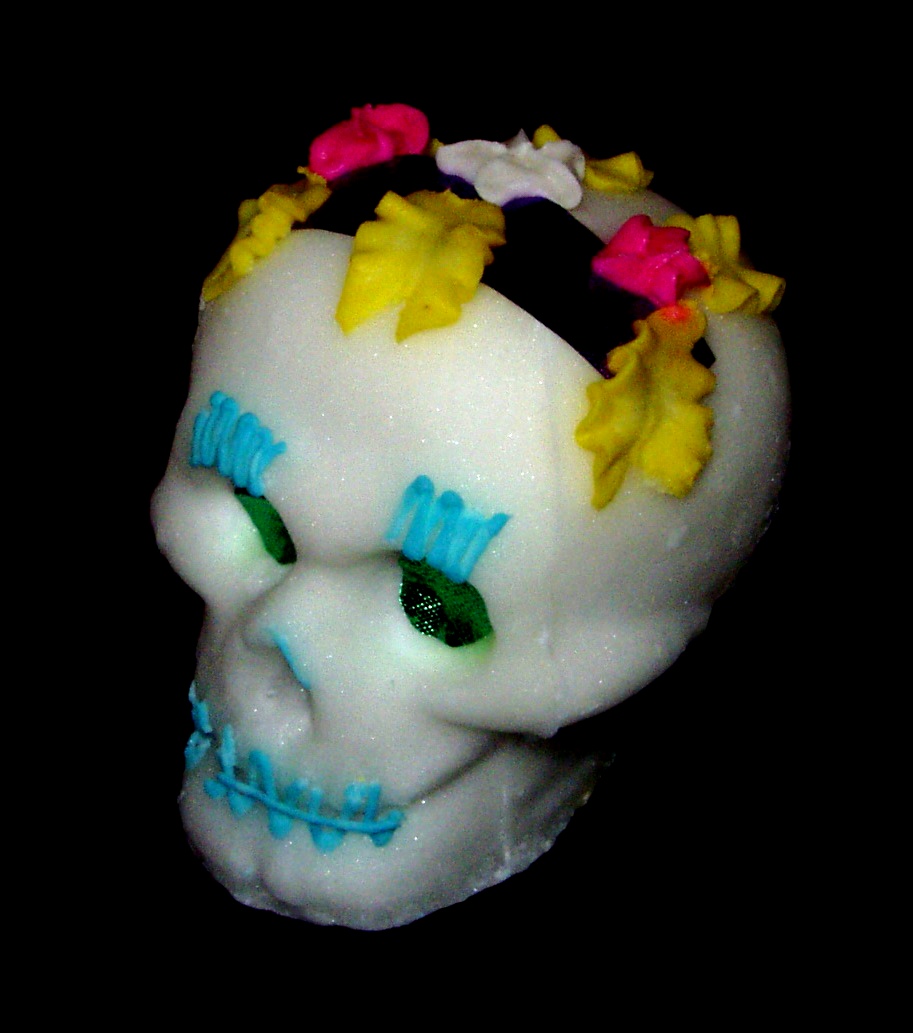Calavera
 A calavera (Spanish – for "skull"), in the context of the Day of the Dead, is a representation of a human skull or skeleton. The term is often applied to edible or decorative skulls made (usually with molds) from either sugar (called Alfeñiques) or clay, used in the Mexican celebration of the Day of the Dead () and the Roman Catholic holiday All Souls' Day. ''Calavera'' can also refer to any artistic representations of skulls or skeletons, such as those in the prints of José Guadalupe Posada, or to gifts or treats in relation to the Day of the Dead. Some widely known ''calaveras'' are created with cane sugar, decorated with items such as colored foil, icing, beads, and sometimes objects such as feathers. They range in multiple colors.
A calavera (Spanish – for "skull"), in the context of the Day of the Dead, is a representation of a human skull or skeleton. The term is often applied to edible or decorative skulls made (usually with molds) from either sugar (called Alfeñiques) or clay, used in the Mexican celebration of the Day of the Dead () and the Roman Catholic holiday All Souls' Day. ''Calavera'' can also refer to any artistic representations of skulls or skeletons, such as those in the prints of José Guadalupe Posada, or to gifts or treats in relation to the Day of the Dead. Some widely known ''calaveras'' are created with cane sugar, decorated with items such as colored foil, icing, beads, and sometimes objects such as feathers. They range in multiple colors.Traditional methods for producing sugar skulls with molds have been in use for a long time, though the first known mention of the sale of skeletal figures dates to the 1740s. The sugar skulls were originally created as gifts, to be eaten by children. They are sometimes now used as offerings to be placed on altars known as ''ofrendas'' ("offerings") for ''Día de Muertos.'' It has been argued that the tradition has roots in indigenous celebrations, by groups including the Aztec, Mayan, and Toltec commemorations. It is also argued what we now call Day of the Dead is more Catholic than indigenous because the Spanish tried to eradicate indigenous religions, forcing most native traditions to hide behind the more similar Spanish ones. Moreover, as Stanley Brandes has argued, these skulls and skeletons have nine characteristics. They are: (1) ephemeral; (2) seasonal; (3) humorous; (4) secular; (5) commercial; (6) made for living people; (7) meant to be played with; (8) small and transportable; (9) made and consumed by an urban population. They are "lighthearted emblems of death."
Sugar skulls were not traditionally used on loved ones' ''ofrendas,'' though they are now. In Mexico, children who have died are celebrated on 1 November. Adults are thought to return on 2 November. It is believed that the departed return home to enjoy the offerings on the altar. Some believe that they consume the essence of the food offerings, others believe they merely sense or savor them without consuming them.
In pre-Columbian times, the images of skulls and skeletons were depicted in stone carvings (and sometimes in the form of real skulls) because bones were thought to be important repositories of life energies and power. The Spanish also used skulls as ''memento mori'' symbols.
During the 19th and 20th centuries, caricaturists, most eminently Manual Manilla and José Guadalupe Posada made influential calaveras, which were accompanied by satirical, rhymed commentaries. The most famous one was Posada's Catrina, who wears a big feathered hat. She was elaborated by Diego Rivera into a full figure with a long dress, and this figure has been reworked by many other artists. Catrina is the most famous figure associated with the Day of the Dead.
During Day of the Dead, skulls and skeletons are created from many materials such as wood, sugar paste, nuts, chocolate, etc. When sugar skulls are purchased or given as gifts, the name of the deceased is often written with icing across the forehead of the skull on colored foil. Provided by Wikipedia
